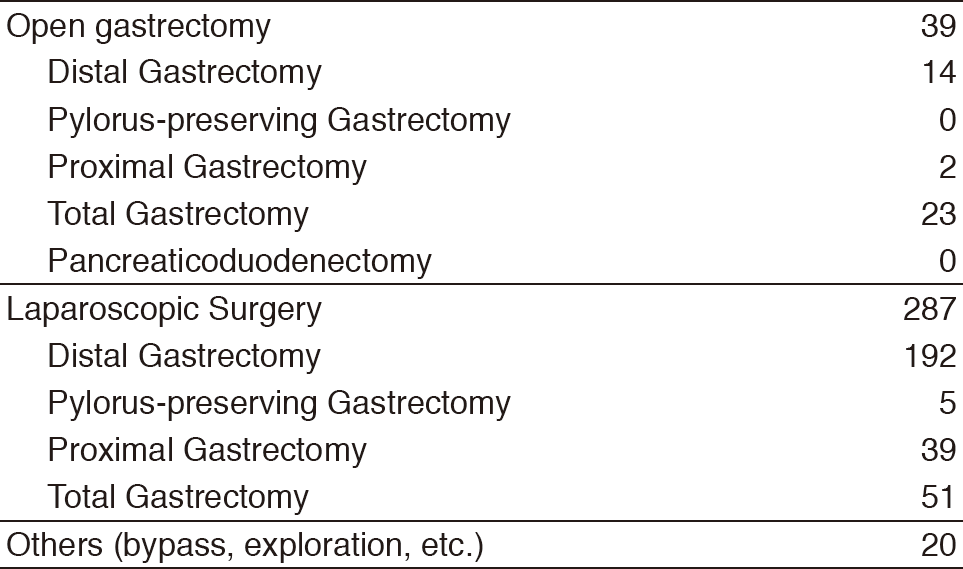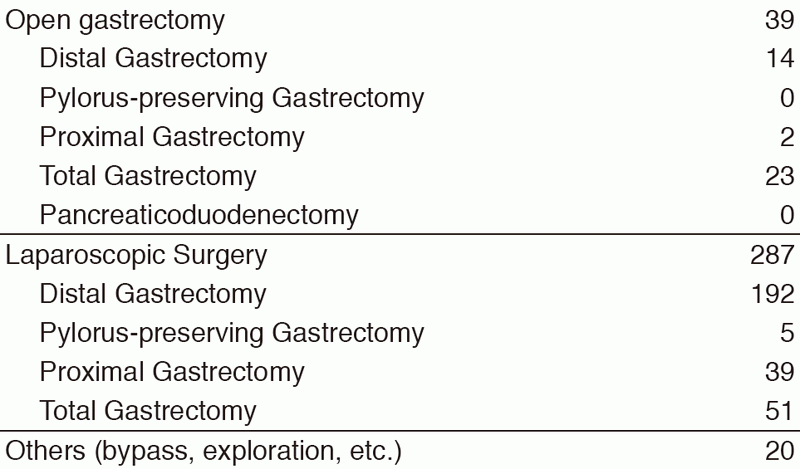Annual Report 2017
Department of Gastric Surgery
Takahiro Kinoshita, Masanori Tokunaga, Akio Kaito, Hideki Sunagawa, Shizuki Sugita, Masahiro Watanabe
Introduction
The Department of Gastric Surgery consists of three staff surgeons, three senior residents, and five junior resident surgeons. Our managing of tumors includes common gastric adenocarcinoma, adenocarcinoma of the esophagogastric junction (AEG: Siewert type 2/3), and gastric submucosal tumors (GIST, etc.). Annually, 260 to 300 patients are operated on, either by means of open surgery or laparoscopic surgery (Table 1). Laparoscopic gastrectomy with radical node dissection was introduced in 2010, and now our department is one of the leading institutions in Japan. In 2017, about 90% of gastrectomies were performed under laparoscopy (Table 2). The basis of our surgery is radical extirpation of cancer lesions, but at the same time, organ functions and better quality of life (QOL) should be maintained. In addition, we strive to obtain better clinical outcomes for patients with diseases with dismal prognoses (type 4 gastric cancer or with progressive metastasis) by surgery combined with a modern chemotherapy regimen, including molecular-targeting drugs in cooperation with medical oncologists.


Our team and what we do
Usually 14 to 16 patients are hospitalized, and six to nine patients undergo operations per week. A clinical conference of our department is held once a week to decide our treatment strategy. Further, a conference with internal medicine is held every Monday evening with doctors of the Department of Diagnostic Radiology, Gastroenterology and Endoscopy, and Gastrointestinal Oncology, discussing the accurate diagnosis of patients with gastric tumors to decide the optimal treatment method for each patient. Every Tuesday morning, a small conference is held with medical oncologists to discuss border-line cases. In principle, patients with low-risk superficial gastric cancer lesions (cT1a) are treated by endoscopic submucosal dissection (ESD) following the criteria of the guidelines. Some are required to undergo subsequent completion laparoscopic surgery with nodal dissection based on pathological findings of specimens obtained by ESD. Laparoscopic surgery covers distal, proximal, pylorus-preserving, and total gastrectomy. D2 dissection can also be done under laparoscopy, and its applicability for advanced cancer is under investigation. When the tumor infiltrates into adjacent organs, extended operations are chosen in some cases. Recently, due to the progress of modern chemotherapy regimen, down-staging from cStageIV is sometimes seen. For such patients, we selectively perform conversion surgery to achieve favorable outcomes. For AEGs, the transhiatal approach can be safely employed under laparoscopy with a better surgical view.
Research activities
We aggressively publish our clinical research data in domestic or international congresses. In addition, we participate in multi-institutional clinical trials conducted by the Japan Clinical Oncology Group (JCOG) - Gastric Surgery Study Group or other international and domestic organizations. Patients with gastric cancer are, if eligible for each study, invited to take part in one of the ongoing clinical trials.
Clinical trials
The list of clinical trials in which we participated in 2017 are listed below.
1) JCOG1301C: A randomized phase II study of systemic chemotherapy with and without trastuzumab followed by surgery in HER2 positive advanced gastric or esophagogastric junction adenocarcinoma with extensive lymph node metastasis (Trastuzumab In Gastric or Esophagogastric junction Adenocarcinoma
2) JCOG1509: Phase III trial to evaluate the efficacy of neoadjuvant chemotherapy with S-1 plus oxaliplatin followed by D2 gastrectomy with adjuvant S-1 in locally advanced gastric cancer (NAGISA trial)
3) A prospective cohort study to evaluate the proper extent of lymph node dissection for esophagogastric junction cancer
4) A Phase III, Randomized, Double-Blind, Clinical Trial of Pembrolizumab (MK-3475) Plus Chemotherapy (XP or FP) Versus Placebo Plus Chemotherapy (XP or FP) as Neoadjuvant/Adjuvant Treatment for Subjects With Gastric and Gastroesophageal Junction (GEJ) Adenocarcinoma (KEYNOTE-585)
5) Extensive Peritoneal Lavage after Curative Gastrectomy for Gastric Cancer: a Randomized Controlled Trial (EXPEL Study)
6) A phase II study of systemic chemotherapy with S-1 and Oxaliplatin followed by gastrectomy with D2 or D2 plus limited para-aortic lymph node dissection in HER2 negative advanced gastric or esophagogastric junction cancer with extensive lymph node metastasis (SOX-D2 study)
7) Venous Thromboembolism (VTE) in Cancer Patients; a Multicenter Prospective Registry
Education
Resident doctors are trained to be specialized surgical oncologists with sufficient techniques and knowledge. Nowadays, opportunities to perform laparoscopic and open surgery are simultaneously given to them. We also place importance on the education of surgeons of other institutions. In 2017, surgeons from domestic and foreign hospitals (from China, Taiwan, Portugal, Spain, Colombia, Argentina, and Russian Federation) visited our department to learn surgical techniques.
Future prospects
We will keep striving to obtain better survival outcomes for patients with far advanced diseases; for multidisciplinary therapy (chemotherapy, molecular-target agents or immune checkpoint inhibitors), collaborating with medical oncologists is essential. Additionally, we will continue to develop less-invasive as well as high quality surgical methods (laparoscopic or robotic surgery), to improve patients' QOL and realize complete cures. It is also our obligation to expand our knowledge and experience globally as one of the most main countries in terms of gastric cancer occurrence.
List of papers published in January 2017 - March 2018
Journal
1. Sunagawa H, Kinoshita T, Kaito A, Shibasaki H, Kaneko K, Ochiai A, Ohtsu A, Nishida T. Additional surgery for non-curative resection after endoscopic submucosal dissection for gastric cancer: a retrospective analysis of 200 cases. Surg Today, 47:202-209, 2017
2. Kinoshita T, Kaito A. Current status and future perspectives of laparoscopic radical surgery for advanced gastric cancer. Translational gastroenterology and hepatology, 2:43, 2017
3. Sunagawa H, Kinoshita T. Three-dimensional computed tomography simulation for laparoscopic lymph node dissection in the treatment of proximal gastric cancer. Translational gastroenterology and hepatology, 2:54, 2017
4. Ito S, Sano T, Mizusawa J, Takahari D, Katayama H, Katai H, Kawashima Y, Kinoshita T, Terashima M, Nashimoto A, Nakamori M, Onaya H, Sasako M. A phase II study of preoperative chemotherapy with docetaxel, cisplatin, and S-1 followed by gastrectomy with D2 plus para-aortic lymph node dissection for gastric cancer with extensive lymph node metastasis: JCOG1002. Gastric cancer, 20:322-331, 2017
5. Tokunaga M, Kaito A, Sugita S, Watanabe M, Sunagawa H, Kinoshita T. Robotic gastrectomy for gastric cancer. Translational gastroenterology and hepatology, 2:57, 2017
6. Higaki E, Yanagi S, Gotohda N, Kinoshita T, Kuwata T, Nagino M, Ochiai A, Fujii S. Intraoperative peritoneal lavage cytology offers prognostic significance for gastric cancer patients with curative resection. Cancer Sci, 108:978-986, 2017
7. Kaito A, Kinoshita T. Educational system of laparoscopic gastrectomy for trainee-how to teach, how to learn. Journal of visualized surgery, 3:16, 2017
8. Aizawa M, Honda M, Hiki N, Kinoshita T, Yabusaki H, Nunobe S, Shibasaki H, Matsuki A, Watanabe M, Abe T. Oncological outcomes of function-preserving gastrectomy for early gastric cancer: a multicenter propensity score matched cohort analysis comparing pylorus-preserving gastrectomy versus conventional distal gastrectomy. Gastric cancer, 20:709-717, 2017
9. Kaito A, Kinoshita T, Tokunaga M, Sunagawa H, Watanabe M, Sugita S, Tonouchi A, Sato R, Abe I, Akimoto T. Prognostic Factors and Recurrence Pattern of Far-advanced Gastric Cancer with Pathologically-positive Para-aortic Lymph Nodes. Anticancer Res, 37:3685-3692, 2017
10. Abe I, Kinoshita T, Kaito A, Sunagawa H, Watanabe M, Sugita S, Tonouchi A, Sato R. Five-year Survival Associated with Stage I Gastric Cancer after Resection of Early Recurrence at Nodal Station No. 14v: a Case Report. Journal of gastric cancer, 17:186-191, 2017
11. Kinoshita T, Masanori T, Akio K. How I do it: technical tips of laparoscopic surgery for advanced gastric cancer. Ann Laparosc Endosc Surg, 2:162, 2017
12. Kataoka K, Kinoshita T, Moehler M, Mauer M, Shitara K, Wagner AD, Schrauwen S, Yoshikawa T, Roviello F, Tokunaga M, Boku N, Ducreux M, Terashima M, Lordick F. Current management of liver metastases from gastric cancer: what is common practice? New challenge of EORTC and JCOG. Gastric cancer, 20:904-912, 2017
13. Kaito A, Kinoshita T, Shitara K, Shibasaki H, Nishida T. Timing of initiation of adjuvant chemotherapy for gastric cancer: A case-matched comparison study of laparoscopic vs. open surgery. Eur J Surg Oncol, 43:801-807, 2017
14. Fukagawa T, Katai H, Mizusawa J, Nakamura K, Sano T, Terashima M, Ito S, Yoshikawa T, Fukushima N, Kawachi Y, Kinoshita T, Kimura Y, Yabusaki H, Nishida Y, Iwasaki Y, Lee SW, Yasuda T, Sasako M. A prospective multi-institutional validity study to evaluate the accuracy of clinical diagnosis of pathological stage III gastric cancer (JCOG1302A). Gastric Cancer, 21:68-73, 2018
15. Sugita S, Kinoshita T, Kaito A, Watanabe M, Sunagawa H. Short-term outcomes after laparoscopic versus open transhiatal resection of Siewert type II adenocarcinoma of the esophagogastric junction. Surg Endosc, 32:383-390, 2018
16. Terada M, Kinoshita T, Kaito A, Sugita S, Watanabe M, Hayashi R. Evaluation of the prognostic factors in patients with pT3N0 or pT1N2-3 gastric cancer: a single institutional retrospective cohort study. Surg Today, 48:325-332, 2018
Book
1. Kaito A, Kinoshita T. Educational system of laparoscopic gastrectomy for trainee?how to teach, how to learn. In: Yong Li, Takahiro Kinoshita, Min-Chan Kim (ed), Notes on Laparoscopic Gastrointestinal Surgery, pp 1-5, 2017
2. Kinoshita T. Technical tips of laparoscopic linear-stapled esophagojejunostomy (overlap method). In: Yong Li, Takahiro Kinoshita, Min-Chan Kim (ed), Notes on Laparoscopic Gastrointestinal Surgery, pp 22-29, 2017


